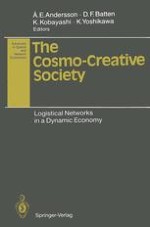1993 | OriginalPaper | Buchkapitel
Some Consequences of ‘Recurrence and Expansion’: What Can We Learn about Logistic Networks from Chaos?
verfasst von : Donald G. Saari
Erschienen in: The Cosmo-Creative Society
Verlag: Springer Berlin Heidelberg
Enthalten in: Professional Book Archive
Aktivieren Sie unsere intelligente Suche, um passende Fachinhalte oder Patente zu finden.
Wählen Sie Textabschnitte aus um mit Künstlicher Intelligenz passenden Patente zu finden. powered by
Markieren Sie Textabschnitte, um KI-gestützt weitere passende Inhalte zu finden. powered by
Understanding a logistic network involves developing an appreciation for the complexities associated with the component parts of a network. This includes an understanding of the movement of money, of commodities, of people, and of the production and consumption of goods and services. (See, for instance, Andersson and Johansson, 1984). The essence of many of these component parts can be captured by seemingly simple models. However, even simple models admit consequences that are surprisingly complex! Paradoxes abound, dynamical motion that intuitively should be ‘simple’ can be highly erratic, and small changes in assumptions can cause radically different conclusions. At first glance, this complexity is surprising if only because much of economics and decision theory is based upon concepts of aggregation and optimization — concepts that one might expect to introduce stability, reliability, and predictability to the conclusions of the resulting model. Yet, this need not be the case. Why?
